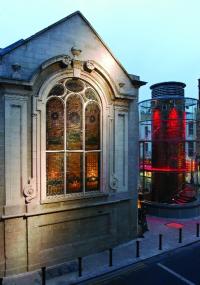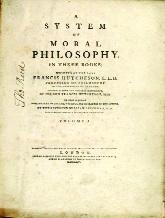Francis Hutcheson memorial planned
Published in 18th–19th - Century History, Early Modern History (1500–1700), General, Issue 5 (Sept/Oct 2011), News, Volume 19
St Mary’s Church today (now The Church Bar and Restaurant), where Francis Hutcheson was buried. No trace of his tomb now remains.
The Belfast-based trade unionist-turned-clergyman Revd Chris Hudson has teamed up with, amongst others, Revd John Marsden, dean of St Bridget’s Cathedral in Kildare, David Begg, ICTU, Patricia McCarthy, a community worker in Dublin’s north inner city, and Robin Frampton, a former loyalist prisoner turned peace activist, to revive interest in Francis Hutcheson, ‘the Father of the Scottish Enlightenment’ and Ireland’s foremost liberal philosopher. Fergus Whelan, secretary to the group, told History Ireland that
‘Protestants, Catholics, Dissenters and others have come together because we believe that Francis Hutcheson is an important figure who transcends the political and religious divisions of Ireland and these islands. We believe that he was Ireland’s and Ulster’s greatest philosopher and that his egalitarian and enlightened ideas have great relevance today as the Republic grapples with economic collapse resulting from unrestrained personal and corporate greed and as Northern Ireland tries to move beyond decades of sectarian division and civil strife.’ Francis Hutcheson was born in the Drumalig manse near Saintfield, Co. Down, in 1694, the son of a Presbyterian minister. Having graduated from the University of Glasgow, he accepted an invitation from the Protestant Dissenters of Dublin to establish a school at Drumcondra Lane in 1719. The school was located near what is now the junction of Dorset Street and Dominick Street. Hutcheson’s lifelong friend Revd Thomas Drennan came to Dublin to help in the school. Revd Drennan’s son, William, would later be a leading United Irishman. When standing trial for his life in 1794, William Drennan claimed that he had been influenced by his father’s friends, whom he recalled were ‘good and great men such as Abernethy, Bruce, Duchal and Hutcheson’. This is a reference to Francis Hutcheson’s Dublin circle. John Abernethy and James Duchal were ministers to a Dissenting congregation based at Wood Street. William Bruce was an elder of that congregation and a publisher of radical political books and pamphlets. Another member of the group was the radical Whig Viscount Robert Molesworth. It is said of this circle that they developed ‘a patriotic spirit that included all Irishmen in its loyalties and diffused a liberal philosophy throughout more than one city or country’.
John Abernethy and James Duchal were ministers to a Dissenting congregation based at Wood Street. William Bruce was an elder of that congregation and a publisher of radical political books and pamphlets. Another member of the group was the radical Whig Viscount Robert Molesworth. It is said of this circle that they developed ‘a patriotic spirit that included all Irishmen in its loyalties and diffused a liberal philosophy throughout more than one city or country’.
Hutcheson loved Dublin, where he lived until 1730. His influential work An inquiry concerning the original of our ideas of beauty and virtue was published in Dublin by William Bruce in 1725. Such was the impact of this work on his contemporaries that Hutcheson was appointed Professor of Moral Philosophy at the University of Glasgow in 1730. Among the many students he taught at Glasgow was Adam Smith. David Hume at Edinburgh acknowledged Hutcheson’s influence on his thinking. Adam Smith described him as ‘the never-to-be-forgotten Hutcheson’ and said that he was ‘undoubtedly and beyond all comparison the most acute, the most distinct, and the most philosophical of all my teachers’. At Glasgow Hutcheson educated a generation of Irish Presbyterian ministers who, inspired by his enlightened values, established the United Irish Society in Belfast in October 1791. His writings also inspired the founders of the United States of America, particularly Thomas Jefferson as he composed the American Declaration of Independence. Francis Hutcheson died in Dublin on 8 August 1746 while visiting his friends in the city. He was interred in an elaborate tomb, sponsored by Alexander Stewart, a prominent Ulster Dissenter and grandfather of the notorious Lord Castlereagh.When St Mary’s churchyard became a public park the graveyard was cleared, headstones were relocated to the edge of the park and any remains were reinterred elsewhere. It is not clear what happened to the Hutcheson tomb but no trace of it now remains. The committee has received enthusiastic support from Brendan Flynn, current proprietor of the building, now The Church Bar and Restaurant, where it is hoped that the plaque will be erected. Mr Flynn believes that promoting the great cultural, historical and literary heritage of the parish of St Mary’s can be of benefit both to the local economy and to the community in the area. On behalf of the committee, Fergus Whelan said that
‘. . . it is unconscionable that Francis Hutcheson now lies in an unmarked grave in the city he loved and where his best work was done. We intend to raise a subscription from cultural organisations, local history societies, and community and church groups to erect a suitable memorial to this great scholar, philosopher, teacher and humanitarian.’ HI
Enquiries: Fergus Whelan (secretary), Francis Hutcheson Memorial Committee, 82 Nephin Road, Cabra, Dublin 7, or Robin Frampton (chairperson), The HUBB Community Resource Centre, 30 St Aubyn Street, Belfast BT15 3QF.
















